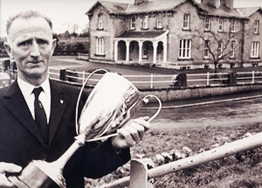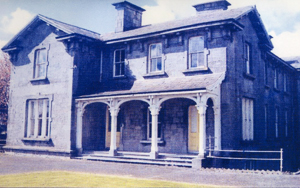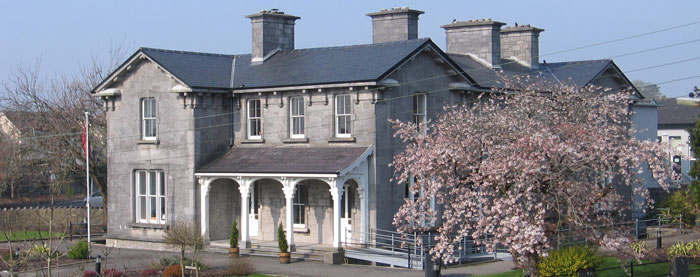âSomething magical happens when you bring together a group of people from different disciplines with a common purposeâ?. - Mark Stefik. Palo Alto Research Centre Fellow.
A Brief History
Long before it became fashionable, what we now know as the vocational education system, promoted the concept of lifelong and life-wide learning. The Department of Agriculture and Technical Education, set up in 1899, led to the establishment of Technical Instruction Committees throughout the country. The first meeting of Co. Galway TIC, under the chairmanship of the Bishop of Galway, Most Rev. Dr. Mc Cormack, met in 1901. The following year, classes were established in the old Workhouses in Ballinasloe, Gort, Glenamaddy, Mountbellew and Portumna, as well as in other rented accommodation in Loughrea and Tuam. Among the subjects taught were Housewifery, Brush making, Net making, Bookbinding, Dressmaking, Shorthand, Typewriting, Model Drawing, Wood Carving, Carpentry and Joinery, Clay Modelling and Basketry.
While the early pioneers of Technical Education were both pragmatic and visionary, not everyone nowadays, ladies in particular, might subscribe to some of Dr. Mc Cormackâs views. At a prize-giving ceremony in Galway in 1895, he stated â There could be no greater advance in civilisation than that the wives and daughters of working men, in town and country, should be competent to serve up to their husbands and brothers, properly cooked and palatable food, however plain and humble. The bar stools would not then be the same attraction.â? (For the men, I presume!)
The steady growth in Technical Education throughout the county in the first quarter of the last century was given a new impetus with the passing of the 1930 Vocational Education Act. The inaugural meeting of Co. Galway VEC was held on November 5th 1930, under the chairmanship of very Rev. Canon Mc Alliney, P.P., An Spidéal. Vocational Education centres were set up in Ballinasloe, Portumna, Loughrea, Gort, Tuam and Clifden. The County Homes or âWorkhousesâ? were used in Gort, Mountbellew, Glenamaddy and Ballinasloe. The central pillars of this Act, on which our current system was built, established the principles of flexibility, accessibility, democratic control, innovation, accountability and responsiveness to local needs. This philosophy has been central to our efforts for the past seventy three years.
Over the years the vocational sector has removed barriers and pushed out the frontiers in terms of developing innovative educational programmes. Swift said, âVision is the art of seeing the invisibleâ?. Vocational teachers have had the vision to see what many either failed to see or chose to ignore. The phenomenal growth of Vocational Education in County Galway can be seen in the ten-fold increase in enrolment in our mainstream schools over the last seventy years.
Vocational schools have never operated on a nine-to-four basis. From the outset we took on the challenge of providing apprenticeship training as well as adult education, leisure courses, Irish summer courses and second chance education in a wide range of evening programmes. We were among the first to embrace the Leaving Certificate Vocational, the Leaving Certificate Applied and, more recently, the Junior Certificate School programmes which are now widely available in the erstwhile more traditional secondary schools. It has also been the vocational sector that first saw the need for Post Leaving Certificate programmes. Hopefully our efforts will maintain the proud tradition of generations of dedicated vocational teachers over the past seventy odd years.
Today:
Today the VEC offers a broad educational service throughout the county both at second level and in its wide network of Adult and Community Education Centres, Literacy schemes, Outdoor Education, VTOS, Youthreach, and Traveller Training programmes. The Committee operates twelve Vocational Schools in the county administrative area, six in the Gaeltacht area - of which three are Island Schools.
-------------------------------------------------------------------------------------------------------
âLearning is a treasure that will follow its owner everywhereâ?. - Chinese Proverb.
-------------------------------------------------------------------------------------------------------
The V.E.C. Headquarters, Athenry; a brief history
| |
|

Martin Gannon, Hotel School Athenry with Rowan Cup, 1970 |

Building Prior to Renovation, 2003 |
| |
|
1696: The first known owners of lands at Cullairbaun were Richard Whaley, Susanna Whaley & Robert Shaw. Lands in the area were also owned by a Thomas James Fetherstonhaugh. The land that the present building is erected on originally consisted of 6 parcels of land with a total acreage of 2,300 statute acres.
Down throughout the decades and centuries the property changed hands several times and in 1959 at a cost of £10,205 the building was refurbished and officially opened as a Hotel Training School. It was utilised by County Galway VEC as a Hotel Training School from 1957 â until the Regional Technical College (now GMIT) rendered it redundant in 1972.
In 1975 the premises was leased by the Department of Agriculture & Fisheries for a period of 7 years. In the 1980's it was utilised by Athenry Vocational School as a pre nursing school. The Building also provided a venue for various PLC courses throughout the 1990's.
On 1st December 2004 the Administrative Offices of County Galway VEC transferred from Galway City to Athenry. The blessing and official opening of the County Galway VEC Administrative Offices took place on 22nd June 2005.
back to top |




 County Galway VEC is part-financed by the European Union
County Galway VEC is part-financed by the European Union